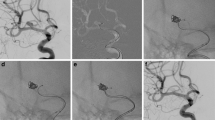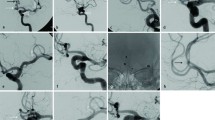Abstract
Endovascular coiling has become a powerful alternative to neurosurgical clipping of cerebral aneurysms. Apart from the Guglielmi Detachable Coil (GDC) (Boston Scientific, Galway, Ireland), there is limited published data about the newer generation of detachable platinum coils, e.g., TruFill (Cordis, Johnson and Johnson, Miami, Fl.). We report our initial clinical experience with the embolization of aneurysms by TruFill coils. Included in this retrospective study were 26 patients (age 55.4±14.5 years; 9 male, 17 female) with 28 aneurysms, 21 ruptured and 7 unruptured. All patients were treated exclusively by embolization with TruFill platinum coils. Immediate angiographic and 6-month angiographic follow-up results were documented. Acute clinical outcome was recorded. Of the 28 aneurysms, 16 (57%) were completely occluded by TruFill embolization, 11 (39%) were incompletely occluded with residual necks, and 1 (4%) was partially occluded as residual aneurysm. There were no aneurysmal ruptures during the procedures. Follow-up at 6 months after the procedure was available in 18 patients and 19 aneurysms. Of the 19 aneurysms, 2 of 12 initially completely occluded aneurysms (17%) and 1 of 7 aneurysms with initial residual necks (14%) showed recanalization at the 6-month follow-up. One recanalized aneurysm was subsequently recoiled with consequent residual neck and remained unchanged at the 1-year follow-up. Embolization by TruFill platinum coils has a comparable total aneurysmal occlusion rate to that with GDC. The mid-term reintervention rate is low, and will require verification by future long-term studies.



Similar content being viewed by others
References
Friedman J, Nichols D, Meyer F, et al (2003) Guglielmi detachable coil treatment of ruptured saccular cerebral aneurysms: retrospective review of a 10-year single-center experience. AJNR Am J Neuroradiol 24:526–533
Raymond J, Roy D (1997) Safety and efficacy of endovascular treatment of acutely ruptured aneurysms. Neurosurgery 41:1235–1246
Tamatani S, Ito Y, Abe H, et al (2002) Evaluation of the stability of aneurysms after embolization using detachable coils: correlation between stability of aneurysms and embolized volume of aneurysms. AJNR Am J Neuroradiol 23:762–767
Benitez R, Silva M, Klem J, et al (2004) Endovascular occlusion of wide-necked aneurysms with a new intracranial microstent (Neuroform) and detachable coils. Neurosurgery 54:1359–1367
Wada H, Piotin M, Boissonnet H, et al (2004) Carotid rupture during stent-assisted aneurysm treatment. AJNR Am J Neuroradiol 25:827–829
Irie T, Maeda M (2003) Placement of 10-millimeter TruFill platinum microcoils in the gastroduodenal artery for intraarterial implantation of a microcatheter-port system to treat liver tumors. J Vasc Interv Radiol 14:265–266
Vinuela F, Duckwiler G, Mawad M (1997) Guglielmi detachable coil embolization of acute intracranial aneurysm: perioperative anatomical and clinical outcome in 403 patients. J Neurosurg 86:475–482
Murayama Y, Nien Y, Duckwiler G, et al (2003) Guglielmi detachable coil embolization of cerebral aneurysms: 11 years’ experience. J Neurosurg 98:959–966
Kuether T, Nesbit G, Barnwell S (1998) Clinical and angiographic outcomes, with treatment data, for patients with cerebral aneurysms treated with Gugliemi detachable coils: a single-center experience. Neurosurgery. Neurosurgery 43:1016–1023
Raymond J, Guilbert F, Weill A, et al (2002) Long-term angiographic recurrences after selective endovascular treatment of aneurysms with detachable coils. Stroke 34:1398–1403
Cognard C, Weill A, Spelle L, et al (1999) Long-term angiographic follow-up of 169 intracranial berry aneurysms occluded with detachable coils. Radiology 212:348–356
Soeda A, Sakai N, Sakai H, et al (2003) Thromboembolic events associated with Guglielmi detachable coil embolization of asymptomatic cerebral aneurysms: evaluation of 66 consecutive cases with use of diffusion-weighted MR imaging. AJNR Am J Neuroradiol 24:127–132
Byrne J (2002) Interventional neuroradiology. Oxford University Press, Oxford New York, pp 108–124
Cognard C, Weill A, Castaings L, et al (1998) Intracranial berry aneurysms: angiographic and clinical results after endovascular treatment. Radiology 206:499–510
Piotin M, Iijima A, Wada H, Moret J (2003) Increasing the packing of small aneurysms with complex-shaped coils: an in vitro study. AJNR Am J Neuroradiol 24:1446–1448
Author information
Authors and Affiliations
Corresponding author
Rights and permissions
About this article
Cite this article
Yan, B., de Rochement, R., Raabe, A. et al. Single-center experience with TruFill platinum coils for the embolization of cerebral aneurysms. Neuroradiology 48, 264–268 (2006). https://doi.org/10.1007/s00234-005-0029-0
Received:
Accepted:
Published:
Issue Date:
DOI: https://doi.org/10.1007/s00234-005-0029-0




